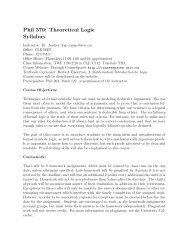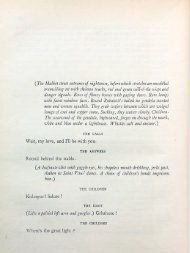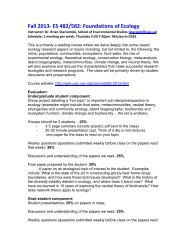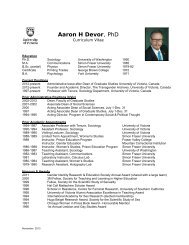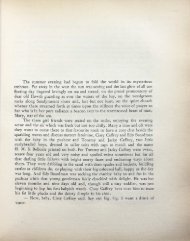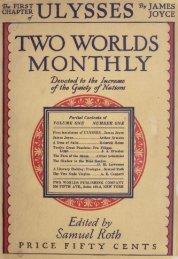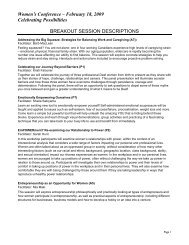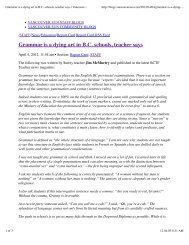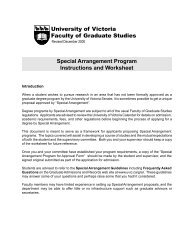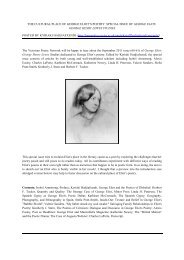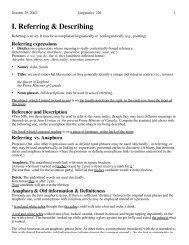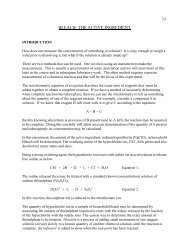"Architecture or Revolution": Taylorism, Technocracy, and Social ...
"Architecture or Revolution": Taylorism, Technocracy, and Social ...
"Architecture or Revolution": Taylorism, Technocracy, and Social ...
Create successful ePaper yourself
Turn your PDF publications into a flip-book with our unique Google optimized e-Paper software.
Pessac, his one mass-housing project, stood<br />
empty f<strong>or</strong> five years as local officials refused<br />
to grant an occupancy permit; <strong>and</strong><br />
finally, the jury of the League of Nations<br />
competition awarded the commission to<br />
four academic architects, who enshrouded<br />
Le C<strong>or</strong>busier's own proposal in masonry<br />
construction <strong>and</strong> hist<strong>or</strong>icist details. Le<strong>and</strong>re<br />
Vaillat's comments on the Esprit Nouveau<br />
pavilion were typical of the suspicion that<br />
many Frenchmen had of Le C<strong>or</strong>busier's<br />
advocacy of the mass-produced dwelling,<br />
the "house-tool":<br />
If this pavilion is in the auth<strong>or</strong>'s intention<br />
a demonstration to teach the<br />
public, which has f<strong>or</strong>gotten it, the<br />
supremacy of construction over <strong>or</strong>nament,<br />
then I approve of it, with the<br />
reservation that none of this is so<br />
new that one wishes it affirmed f<strong>or</strong><br />
us; but if he intends to persuade us,<br />
with a f<strong>or</strong>cefulness that has nothing<br />
persuasive about it, that a house is a<br />
"machine f<strong>or</strong> living," no. A house<br />
is not a fact<strong>or</strong>y where one w<strong>or</strong>ks <strong>and</strong><br />
where, in <strong>or</strong>der to earn a little paper<br />
money, one perf<strong>or</strong>ms a few mechanical<br />
gestures, always the same. A<br />
house, to be sure, must be answerable<br />
to logic, reason, <strong>and</strong> good sense,<br />
<strong>and</strong> we find, thank God! enough of<br />
these qualities in our national <strong>and</strong><br />
regional traditions, without seeking<br />
them in German-Swiss rationalism.109<br />
Critics, f<strong>or</strong>ever aware of Germany's industrial<br />
superi<strong>or</strong>ity, often condemned eff<strong>or</strong>ts<br />
to implement Scientific Management<br />
as not French. Indeed, Walter Rathenau,<br />
Germany's Minister of Reconstruction <strong>and</strong><br />
one of Europe's most significant thinkers<br />
on industrial <strong>or</strong>ganization, had contributed<br />
an article in the midst of reparations anxiety<br />
to L'Esprit Nouveau "Critique de L'Esprit<br />
Allem<strong>and</strong>. "110 The Figaro writer Mauclair,<br />
elab<strong>or</strong>ating on de Senger's argument,<br />
related the anonymity <strong>and</strong> regularity of Le<br />
C<strong>or</strong>busier's mass-produced architecture to<br />
the objectives of Bolshevism. Both wanted<br />
to destroy man's spiritual c<strong>or</strong>e: to reduce the<br />
Frenchman to an " animal g6ometrique.<br />
" C<strong>or</strong>busier's <strong>or</strong> the Redressement's ref<strong>or</strong>ms. Nineteenth <strong>and</strong> Twentieth Centuries, Balti-<br />
Mercier admitted his failure, but attributed m<strong>or</strong>e, Penguin, 1971, <strong>and</strong> Sigfried Giedion's<br />
it, in language reminiscent of his colleague, Space, Time, <strong>and</strong> <strong>Architecture</strong>, Cambridge,<br />
to the public's insensitivity to "wisdom, Mass., Harvard University Press, 1967,<br />
moderation, prudence, <strong>and</strong> disinterested- largely ign<strong>or</strong>e the political implications of<br />
ness." As Kuisel points out, Albert Thi- Le C<strong>or</strong>busier's w<strong>or</strong>k. Charles Jencks's biogbaudet<br />
gave another m<strong>or</strong>e convincing ex- raphy, Le C<strong>or</strong>busier <strong>and</strong> the Tragic View of<br />
planation f<strong>or</strong> the technocrats' failure to <strong>Architecture</strong>, Cambridge, Mass., Harvard<br />
achieve ref<strong>or</strong>m: Neo-Saint-Simonianism, University Press, 1973, after a brief recapithe<br />
claimed, had allied itself too<br />
ulation of Le C<strong>or</strong>busier's<br />
strongly<br />
contradict<strong>or</strong>y political<br />
with the defense of economic interests to positions, dismisses his "quasi-fascism"<br />
on the<br />
speak with grounds of artistic purity. In recent<br />
auth<strong>or</strong>ity as a broad ideological<br />
movement. 112<br />
years, however, several scholars have begun<br />
to expl<strong>or</strong>e m<strong>or</strong>e extensively Le C<strong>or</strong>busier's<br />
F<strong>or</strong> Le C<strong>or</strong>busier as an architect, the<br />
political connections. See especially Robert<br />
detachment from party politics was perhaps Fishman, Urban Utopias in the Twentieth<br />
a special temptation. Visions of industrial Century: Ebenezer Howard, Frank Lloyd<br />
utopia, unlike Marxism, offered both the Wright, <strong>and</strong> Le C<strong>or</strong>busier, New Y<strong>or</strong>k, Basic<br />
promise of social redemption <strong>and</strong> a means Books, 1977; Jean Louis Cohen, "Le C<strong>or</strong>by<br />
which to continue to practice one's art. busier <strong>and</strong> the Mystique of the U.S.S.R.,"<br />
Although by 1930 Le C<strong>or</strong>busier's faith in Oppositions no. 23 (Winter 1981), pp. 85-<br />
America's model of industrial productivity 121; Gi<strong>or</strong>gio Ciucci, "A Rome con Bottai,"<br />
was shaken, the search f<strong>or</strong> this dual goal Rassegna 2, no. 3 (July 1980), pp. 66-71;<br />
was to persist. The new ideology of pro- Thilo Hilpert, Die Funktionelle Stadt Le<br />
duction had changed the architect's con- C<strong>or</strong>busier's Stadtvision-Bedingungen,<br />
ception of his social role; housing, urban Motive, Hintergrunde, Brunswick, Vieweg,<br />
planning, <strong>and</strong> modem construction meth- 1978.<br />
ods are in part the legacy of the perished 4 Blake, Master Builders, p. 109.<br />
hopes of the 1920s.<br />
5 Le C<strong>or</strong>busier, Urbanisme, Paris, Editions<br />
Notes<br />
Cres, 1925; reprinted in Paris, Vincent,<br />
I should like to acknowledge my appreciation to Freal, 1966. Translated into English by<br />
Frederick Etchells in Le<br />
the <strong>Social</strong> Science Research Council <strong>and</strong> the<br />
C<strong>or</strong>busier, The City<br />
Alliance Frangaise Fribourg Foundation of Tom<strong>or</strong>row <strong>and</strong> Its Planning, London,<br />
(Ful-<br />
John<br />
bright-Hayes) f<strong>or</strong> providing funding f<strong>or</strong> Rodker, 1929; reprinted in Cambridge,<br />
my<br />
research in Paris 1976-1977. Also I should like Mass., 1971, p. 301.<br />
to thank the staff of the Fondation Le C<strong>or</strong>busier 6 Judith A. Merkle, Management <strong>and</strong> Ideolf<strong>or</strong><br />
their assistance, as well as Susan Ball, ogy, Berkeley, University of Calif<strong>or</strong>nia<br />
Elean<strong>or</strong> Gregh, Kenneth Silver, Francesco Pas- Press, 1980, pp. 14-15.<br />
santi, <strong>and</strong> Anthony Vidler, whose conversations<br />
7 An<br />
<strong>and</strong> writings have been especially helpful to the imp<strong>or</strong>tant source f<strong>or</strong> this account of Tayl<strong>or</strong>ism<br />
f<strong>or</strong>mulation of many of the article's<br />
<strong>and</strong>, in<br />
ideas. Alan<br />
particular, its ideological im-<br />
Colquhoun, Marc Treib, Robin Evans, <strong>and</strong> plications in Europe is Charles S. Maier's<br />
excellent article, "Between<br />
Richard Pommer have most generously reviewed<br />
Tayl<strong>or</strong>ism <strong>and</strong><br />
<strong>and</strong> commented on my draft.<br />
<strong>Technocracy</strong>: European Ideologies <strong>and</strong> the<br />
Vision of Industrial Productivity in the<br />
1 "Beyond the Modem Movement," The 1920s," Journal of Contemp<strong>or</strong>ary Hist<strong>or</strong>y<br />
Harvard <strong>Architecture</strong> Review no. 1 (Spring 5, no. 2 (1970), pp. 27-61.<br />
1980) 6; Charles Jencks, The Language of<br />
8 Henri Le<br />
Post-Modern <strong>Architecture</strong>, 3rd ed., New<br />
Chatelier, Le Tayl<strong>or</strong>isme, 2nd ed.,<br />
Y<strong>or</strong>k, Rizzoli, 1981, p. 37. These<br />
Paris, Dunod, 1934, p. 2.<br />
critiques<br />
are directed at the Modem Movement as a 9 Paul Devinat, Scientific Management in<br />
1l whole.<br />
Europe, Geneva, International Lab<strong>or</strong> Office,<br />
To some extent, however, Le C<strong>or</strong>bu- 2 Reyner Banham, The<strong>or</strong>y <strong>and</strong> Design in the<br />
1927, pp. 233-37; Richard K. Kuisel, Capitalism<br />
<strong>and</strong> the State in Modern France,<br />
sier's failure to attain a mass-produced First Machine Age, 2nd ed., New Y<strong>or</strong>k,<br />
architecture was his own. Like Mercier, he Praeger Publishers, 1960; Colin Rowe, "The Cambridge, Cambridge University Press,<br />
hardly chose the most effective means of Mathematics of the Ideal Villa," The Mathe- 1981, pp. 31-35.<br />
exerting his influence. His hope to influ- matics of the Ideal Villa <strong>and</strong> Other Essays, 10 These statistics, prepared by the French<br />
ence policy decisions while maintaining<br />
Cambridge, Mass., MIT Press, 1976, pp. Ministry of the Liberated Regions, are from<br />
independence from politics was naive. 1-27; William Curtis, "Ideas of Structure William MacDonald, Reconstruction in<br />
Technicians <strong>and</strong> architects had been effec<strong>and</strong><br />
the Structure of Ideas: Le C<strong>or</strong>busier's France, New Y<strong>or</strong>k, MacMillan, 1922, pp.<br />
Pavillon<br />
tive functioning as officials <strong>or</strong> advis<strong>or</strong>s<br />
Suisse, 1930-1931," Journal of 24,28,93.<br />
the Society<br />
within the government-f<strong>or</strong> instance, Ernst<br />
of Architectural Hist<strong>or</strong>ians 40,<br />
11 Kuisel,<br />
no. 4 (December 1981),<br />
May in Frankfurt <strong>or</strong> Henri Sellier in Paris<br />
pp. 295-310.<br />
Capitalism, pp. 54, 61.<br />
12 Lt. Col. G.<br />
<strong>and</strong> Suresnes-but Le C<strong>or</strong>busier naively 3 See in particular Maximilien Gauthier Le<br />
Espitallier, Pour rebdtir nos<br />
maisons<br />
believed that he could shape government C<strong>or</strong>busier ou l'architecture au service de<br />
detruites, Paris, 1917, p. 3, cited<br />
policy simply by offering unsolicited ad- l'homme, Paris, Editions<br />
by Kenneth Silver, "Esprit de C<strong>or</strong>ps: The<br />
Denoel, 1944;<br />
Great War <strong>and</strong> French<br />
vice. The leadership of the Republic, re- Stephen Gardner, Le C<strong>or</strong>busier, New<br />
Art, 1914-1925,"<br />
Y<strong>or</strong>k,<br />
sponding to a much larger constituency Viking Press, 1974; Peter Blake, The Master<br />
dissertation, Yale University, 1981, pp.<br />
207-8.<br />
<strong>and</strong> one that was often hostile to innova- Builders, New Y<strong>or</strong>k, Alfred A. Knopf, 1960.<br />
tion, had little reason to initiate either Le Henry-Russell Hitchcock's <strong>Architecture</strong>: 13 Charles-Edouard Jeanneret <strong>and</strong> Amedee<br />
144 Art Journal



